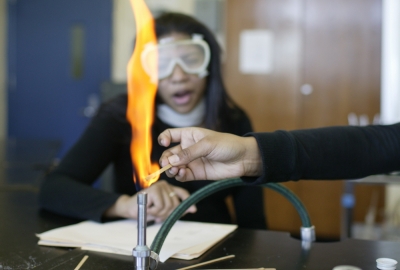
About Design2Learn
Design2Learn is an afterschool program for students in middle school—a period in which student performance in science often declines sharply. The program is aimed at increasing students’ interest, engagement, and academic performance in science. Students participate in weekly science instruction after school, facilitated by a trained three-person educator team (one certified teacher; two informal educators from a partnering nonprofit) and designed to connect science learning goals to real-world activities. Students enroll in Design2Learn in sixth grade, and continue the program through eighth grade.
The program combines three strategies: 1) collaborative teaching, which brings together certified teachers and staff employed by non-profit organizations that provide school-based after-school programs to jointly deliver instruction; 2) curricular bridging, which coordinates in-school and after-school instruction to create seamless student learning experiences; and 3) design-based learning, which provides students with hands-on, real-world activities. Evidence has begun to support the use of each of these strategies independently, but Design2Learn is a novel effort to combine them to support student interest and engagement in science.
Design2Learn was created by ExpandED Schools, and is offered in collaboration with the New York Hall of Science (NYSCI).
About Our Study
The Research Alliance is leading an external evaluation of the implementation and impact of Design2Learn in NYC middle schools. This work is funded through the federal Investing in Innovation (i3) grant program, which is designed to foster innovation and provide support to implement, study, and scale-up promising ideas.
Beginning in the fall of 2016, we randomly assigned middle schools to participate in Design2Learn or to implement their ‘business as usual’ STEM programing. This rigorous random assignment design will allow us to estimate the causal effect of Design2Learn on students.
Within each school, we will study one educator team and at least 25 students from 6th through 8th grade. We are studying a group of nine treatment and nine control schools beginning in fall 2016, and will add a second set of schools in August 2017.
Our evaluation will study Design2Learn’s implementation, to learn whether three key elements of the program—professional development, strategic planning to coordinate curriculum across in-school and after-school staff, and instructional coaching provided by ExpandED Schools and NYSCI—are being provided as intended.
We will also measure the impact of Design2Learn on a range of student outcomes, including interest and engagement in science and science achievement (as measured by standardized science achievement tests and course grades). Finally, we will explore how these impacts differ for various subgroups of students, including girls, English language learners, low-income students, students with prior low academic achievement, and students from different racial and ethnic backgrounds.
Supported by the U.S. Department of Education’s Investing in Innovation Fund.


